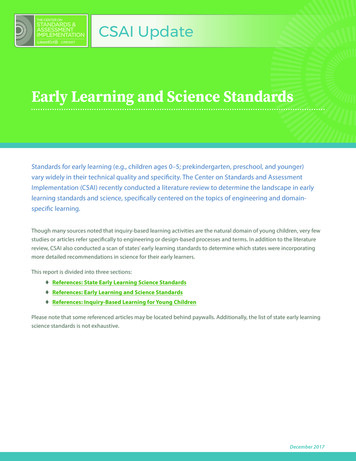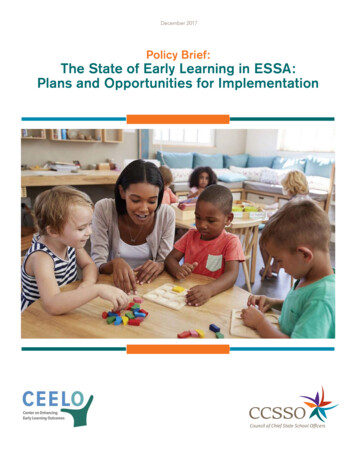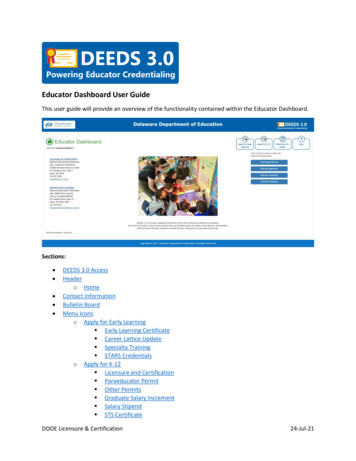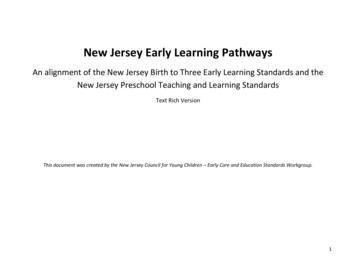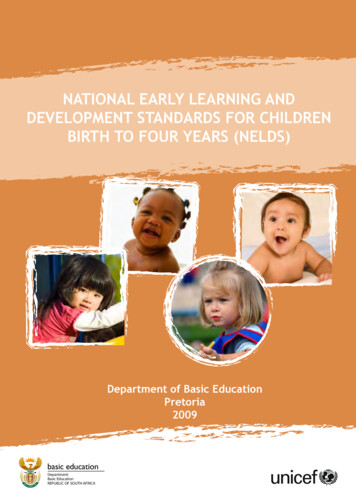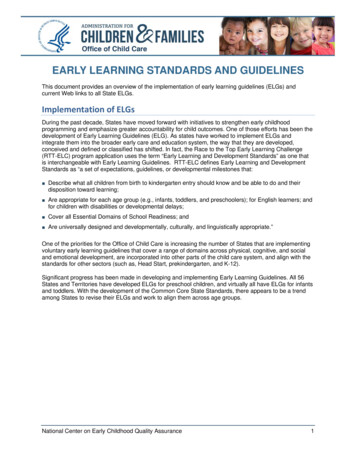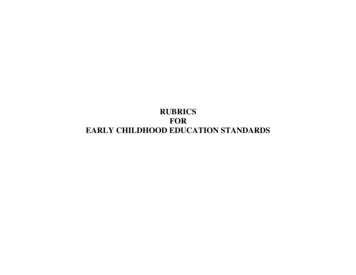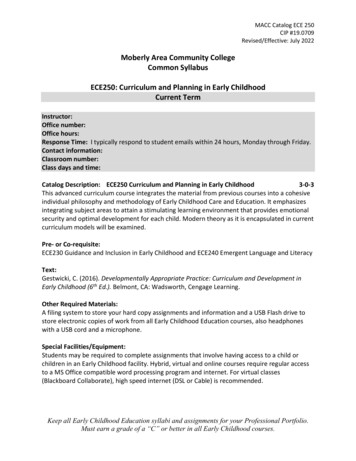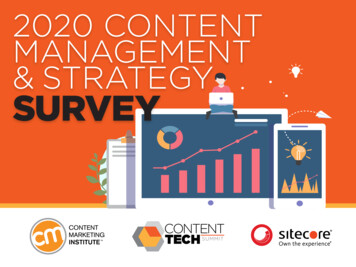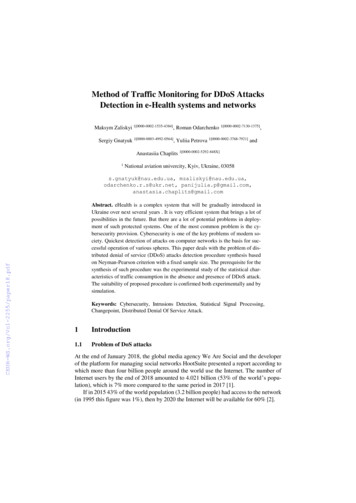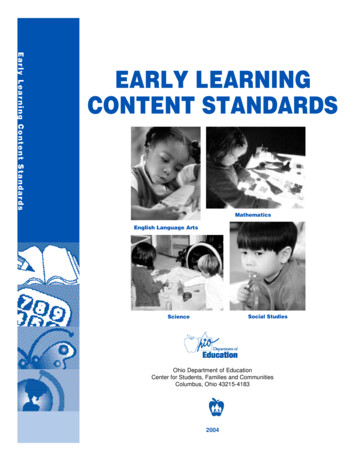
Transcription
EARLY LEARNINGCONTENT STANDARDSMathematicsEnglish Language ArtsSocial StudiesScienceOhio Department of EducationCenter for Students, Families and CommunitiesColumbus, Ohio 43215-41832004
State Board of Education of OhioJennifer L. Sheets, Pomeroy, PresidentRichard E. Baker, Hollansburg, Vice PresidentVirgil E. Brown, Jr., Shaker HeightsMichael Cochran, BlacklickJim Craig, CantonJohn W. Griffin, West CarrolltonRobin C. Hovis, MillersburgVirginia E. Jacobs, LimaStephen M. Millett, ColumbusDeborah Owens Fink, RichfieldCyrus B. Richardson, Jr., BethelEmerson J. Ross, Jr., ToledoG. R. "Sam" Schloemer, CincinnatiJennifer H. Stewart, ZanesvilleJo Ann Thatcher, McDermottJames L. Turner, CincinnatiSue Westendorf, Bowling GreenCarl Wick, CentervilleMartha W. Wise, AvonEx Officio MembersSenator Robert A. Gardner, MadisonRepresentative Arlene J. Setzer, VandaliaOhio Department of EducationSusan Tave Zelman,Superintendent of Public InstructionCenter for Students, Families and CommunitiesJane Wiechel, Associate SuperintendentOffice of Early Learning and School ReadinessSandra Miller, DirectorEdith Greer, Associate DirectorDebbie McGlothlin, Consultant, Project CoordinatorThis document is a publication of the Ohio Department of Education and does not representofficial policy of the State Board of Education unless specifically stated.
E a r l yL e a r n i n gC o n t e n tS t a n d a r d sDear Early Childhood Education Teacher,Ohio’s Early Learning Content Standards provide the guidance required tohelp all of our youngest children enter kindergarten ready for success. Thesestandards describe the knowledge and skills that can serve as the foundation formeaningful early learning experiences. They are aligned with our kindergartenthrough grade 12 standards and thus provide a framework for preschool throughprimary grade connections, teaching strategies and transition practices. InDecember 2003, the State Board of Education adopted these standards, animportant step in the creation of a seamless P-12 education system.I want to thank all of the content writing team members – teachers, providers,higher education faculty and program administrators – who provided theleadership for the development of our early learning standards. To view thecomplete set of standards, pre-kindergarten through grade 12, visit the OhioDepartment of Education Web site at www.OhioAcademicStandards.com.I wish you much success in your work and thank you for providing thevery best education to all of our children.Sincerely,Susan Tave ZelmanSuperintendent of Public Instruction1
E a r l yL e a r n i n gC o n t e n tS t a n d a r d sDear Early Childhood Education Teachers,The Ohio Department of Education (ODE) and Ohio Department of Job and FamilyServices (ODJFS) are working in partnership to ensure that all of our youngest learnersenter kindergarten ready for success. Ohio’s Early Learning Content Standards serve asan important framework for creating learning experiences and designing teaching strategiesto meet the needs of all children.These standards express a shared vision of what our children should experience, learnand know as a result of quality early education and care programs. In addition, theyprovide a common base with which we can assess how we are helping our childrenreach their goals and offer a direction for professional development.While the early learning content standards are grounded in the research within eachdiscipline – English language arts, mathematics, social studies and science – the ways inwhich we develop quality curriculum and experiences should address the unique learningprocesses of preschool children.We offer four principles that can ser ve as a lens for planning early learning experiences:All children are born ready to learn – starting our experiences from theplace of potential and ability;Relationships are influential – ensuring that we meet the social andemotional needs of our children in the ways in which we design ouractivities and relate to our children;Communication is critical – recognizing the importance of language asthe foundation for all learning, designing experiences that capitalize onintroducing print in a variety of meaningful ways;Environments matter – designing our learning spaces to reinforce andsupport what children are learning.On behalf of the ODE’s Office of Early Learning and School Readiness and ODJFS’sBureau of Child Care and Development, we thank you for your commitment to helping allof our children succeed.Sandra Miller, DirectorOffice of Early Learning and School ReadinessOhio Department of Education2Terrie Hare, ChiefBureau of Child Care and Family DevelopmentOffice for Children and FamiliesOhio Department of Job and Family Services
E a r l yL e a r n i n gC o n t e n tS t a n d a r d sTable of ContentsOverview . . . . . . . . . . . . . . . . . . . . . . . . . . . . . . . . . . . . . . . . . . . . . . . . . . . 5Standards and IndicatorsEnglish Language Arts. . . . . . . . . . . . . . . . . . . . . . . . . . . . . . . . . . . . 10Mathematics. . . . . . . . . . . . . . . . . . . . . . . . . . . . . . . . . . . . . . . . . . . . 27Science . . . . . . . . . . . . . . . . . . . . . . . . . . . . . . . . . . . . . . . . . . . . . . . 36Social Studies . . . . . . . . . . . . . . . . . . . . . . . . . . . . . . . . . . . . . . . . . . 44Glossary. . . . . . . . . . . . . . . . . . . . . . . . . . . . . . . . . . . . . . . . . . . . . . . . . . . 52Resources . . . . . . . . . . . . . . . . . . . . . . . . . . . . . . . . . . . . . . . . . . . . . . . . . 593
E a r l y4L e a r n i n gC o n t e n tS t a n d a r d s
E a r l yL e a r n i n gC o n t e n tS t a n d a r d sOverview“The early years of schooling are an important period of development. It is inpre-kindergarten through third grade that children learn to read and write,acquire a basic understanding of content areas and develop importantdispositions toward learning. It is also a time to begin the process of assessingchildren’s performance related to the standards” (Helm & Gronlund, 2000).In response to Amended Substitute House Bill 94 of 2001, the Ohio Departmentof Education’s (ODE’s) Office of Early Learning and School Readiness and theOffice of Curriculum and Instruction collaborated to convene Ohio stakeholdersto develop early learning content standards for English language arts, mathematics, social studies and science.The early learning content standards describe essential concepts and skills foryoung children. Based on research, these achievable indicators emerge as theresult of quality early learning experiences regardless of the setting(e.g., nursery school, preschool, family care, etc.). In addition, the early learningcontent indicators are aligned to the K-12 indicators, benchmarks and standardsthat result in a seamless educational framework for children pre-kindergartenthrough kindergarten and primary grades.Membership of the writing teams for the development of the content indicatorswas selected from a pool of nominees representing Ohio’s early childhoodstakeholders. They included Head Start; public and private preschool teachers;kindergarten teachers; program administrators and faculty members from highereducation teacher preparation institutions. The team was balanced to includerepresentation from geographic areas of the state, as well as ethnic diversity.A draft of the early learning content standards for the four content areas wasdisseminated for review and focused feedback from experts within and outside ofOhio. It also was posted on the ODE Web site for broad public input. Final revisionsto the early learning content standards were made based on feedback from the field.These early learning standards serve as a framework for designing andimplementing meaningful curricula and intentional learning experiences withinall preschool and child care settings. The early learning standards are theexpectations for the end of the preschool years and thus serve as a guide forparents and provide the foundation for professional development.5
E a r l yL e a r n i n gC o n t e n tS t a n d a r d sWriting Team MembersThe Ohio Department of Education, Office of Early Learning and SchoolReadiness and Office of Curriculum and Instruction express our sincereappreciation to the writing team members who contributed their expertiseand time to the development of Ohio’s Early Learning Content Standards. Thefollowing members represent the many individuals across the state dedicated totheir profession and to high-quality early education and care for all of Ohio’syoung children:English Language Arts:6Jennifer Davis, Preschool TeacherBarbara Phillips, ConsultantPutnam County Education Service CenterOhio Department of EducationSherry DeWyer, AdministratorBarbara Nourse, CoordinatorHenry County MR/DDNorthwest Even StartColleen Finegan, Associate ProfessorSandra Redmond, AdministratorWright State UniversityCuyahoga Community CollegePauline Gaskalla, Kindergarten TeacherKaren Santilli, Preschool TeacherNelsonville-York City SchoolsColumbus City SchoolsPamela Jones, Preschool TeacherJane Snow, Speech/Language PathologistOrchard School of ScienceFlying Colors PreschoolKelly Kuhn, Preschool TeacherBarbara Trube, Assistant ProfessorMansfield City SchoolsShawnee State UniversityDeborah McGlothlin,ConsultantSuzanne Van Leer, Kindergarten TeacherOhio Department of EducationCleveland Municipal SchoolsAvalene Neininger, Preschool TeacherJohn Webb, AdministratorCoshocton County MR/DDCincinnati-Hamilton County CAC
E a r l yL e a r n i n gC o n t e n tS t a n d a r d sMathematics:Ruth Al-Esail, Kindergarten TeacherPatricia Harper, Preschool TeacherAthens City SchoolsKent City SchoolsMarcia Barnhart, Kindergarten TeacherDeborah McGlothlin, ConsultantLeipsic Local SchoolsOhio Department of EducationFrancie Berg, Preschool TeacherBarbara Phillips, ConsultantCoshocton City SchoolsOhio Department of EducationMargaret Bramel, AdministratorLois Popejoy, Preschool TeacherSouth-Western City SchoolsToronto City SchoolsAnn Deal, Preschool TeacherFran Rodstrom, Preschool TeacherSinclair Community CollegeKnox County Education Service CenterBrendan Foreman, Assistant ProfessorNiketa Starr, Preschool TeacherJohn Carroll UniversityCleveland Municipal SchoolsEugene Geist, ProfessorWendy Tyger, AdministratorOhio UniversityMahoning County Educational Service CenterJamie Harmount, AdministratorHighland County CACScience:Gretchen Snyder-Barrett, Preschool TeacherLouann Kunisch, AdministratorAllen County MR/DDErie-Huron Educational Service CenterNancy Hockenberry, AdministratorKathy Reschke, FacultyColumbiana County EducationalThe Ohio State UniversityService CenterNancy Hultz, Adjunct FacultyColleen Wainwright, AdministratorNorth Central State Community CollegeMiami University-Middletown EarlyChildhood CenterDebra Kimble, FacultyAnnie Widden, AdministratorClark State Community CollegeSt. Rose of Lima School7
E a r l yL e a r n i n gC o n t e n tS t a n d a r d sSocial Studies:Mary Candelaria, Early Childhood Specialist Kelly Schattsneider, AdministratorChild Development Council of FranklinCountyAuglaize County Educational ServiceCenterCorrine Doege, AdministratorLinda Norton-Smith, Preschool TeacherStark County Educational ServicePrivate Child Care CenterCenterLinda Herold, Preschool TeacherMichelle Turner, Preschool TeacherCuyahoga Falls United DisabilitiesAllen County MR/DDServices8Eunsock Hyun, ProfessorSally Wooley, Preschool TeacherKent State UniversityAllen County MR/DDNancy Hultz, Adjunct FacultyDeborah Zurmehley, Assistant ProfessorNorth Central State Community CollegeOhio University-Chillicothe
E a r l yL e a r n i n gC o n t e n tS t a n d a r d sLearning to read and write is one of the most important and powerfulachievements in life. Its value is clearly seen in the faces of young children –the proud, confident smile of a capable reader contrasts sharply with thefurrowed brow and sullen frown of the discouraged non-reader. Ensuringthat all young children reach their potentials as readers and writers is theshared responsibility of teachers, administrators, families and communities.Educators have a special responsibility to teach every child and not to blamechildren, families, or each other when the task is difficult. All responsibleadults need to work together to help children become competent readers andwriters.National Association for the Education of Young Children (NAEYC), 19989
E a r l yL e a r n i n gC o n t e n tS t a n d a r d sEnglish Language ArtsThe emergence of language and literacy in young children is a dynamicprocess. The research is clear : children who enter kindergarten "language rich,"that is, using and knowing many different words, engaging in conversations withother children and adults, sharing information and asking questions, come toschool ready to participate in reading instruction.It is also clear from the research that there are "clear and consistent patterns ofrelationship between children’s language and literacy development" (Dickinsonand Tabors, 2001). Speaking, listening, reading and writing are bound togetheras a system that is useful and has meaning for young learners. Language andliteracy are interactive processes. When children are immersed in anenvironment where oral and written communications are valued, they have themotivation, the modeling and the sense of purpose to master language.During the preschool years, with appropriate guidance and curriculumexperiences, children turn conscious attention to print. They acquire conceptsabout print such as linearity and directionality and learn to write their namesand recognize and write some alphabet letters. They develop early phonologicalawareness through hearing stories and rhymes and playing games with rhymingwords and alliteration. In addition, young children learn to listen to and talkabout books that are read aloud to them.They construct understandings about avariety of kinds of books and print in the environment and begin to develop aconcept about story. The young learners’ vocabularies grow as they acquireunderstanding of new words through their experiences, including experienceswith books.Over the past few years, practitioners and researchers have studied howchildren learn to read, write and understand language. The concepts childrenneed to become competent and confident readers and writers and the kinds ofexperiences that help them make progress have been identified. Based on thisresearch, the key components or "big ideas" of effective early literacy programsinclude vocabulary and oral language development; phonological awareness;awareness and knowledge of print; letters and words; comprehension;awareness and knowledge of books and other texts; and beginning awarenessand understanding of the process, composition and conventions of writing. Adeep understanding of these key components can assist early childhood10
E a r l yL e a r n i n gC o n t e n tS t a n d a r d seducators in planning and developing preschool curriculum and in designingappropriate and effective early literacy experiences for young children.Developing a strong foundation for literacy doesn’t just happen. Instead, earlychildhood educators must thoughtfully and purposefully interact with childrenand plan experiences that support emerging literacy. During these first years ofchildren’s reading and writing, wide exposure to print and to developing conceptsabout its forms and functions are emphasized. Classrooms filled with meaningfulprint, language and literacy play, storybook reading and writing allow children toexperience the joy and power associated with reading and writing. A print-richenvironment that allows children to engage in hands-on experiences that offercountless opportunities to practice literacy skills in real-life, combined with explicitteaching of key concepts is the foundation of literacy learning in preschool.The relation of thought to word is not a thingbut a process.Vygotsky, 198611
E a r l yL e a r n i n gC o n t e n tS t a n d a r d sPhonemic Awareness, Word Recognition and Fluencyfor Early ChildhoodA key finding in recent research has been the importance of developing phonologicalawareness in children during the preschool years. Phonological awareness is hearingand understanding the different sounds of spoken language. It includes the differentways oral language can be broken down into individual parts (for example, separatesounds and syllables).The skills that make up phonological awareness are on acontinuum of complexity. The most basic level includes skills such as playing withrhymes, noticing how words begin with the same sounds or clapping out individualwords or syllables of a song, rhyme or chant. Playing with sounds in speech helpschildren in their growing understanding of phonemic awareness – the ability to hear,identify and manipulate the individual sounds (phonemes) in spoken language.Although phonemic awareness is not an expectation for preschool, some preschoolchildren demonstrate the ability to take words apart, sound by sound. Phonemicawareness is addressed in kindergarten curriculum.Preschool-age children also begin to recognize some printed alphabet letters andwords, especially the ones found in their own names. Knowing about letters involvesunderstanding that a letter is a symbol that represents one or more sounds in theEnglish language, that these symbols can be grouped together to form words andthat these words have meaning. To support young learners, early childhood educatorsshould draw children’s attention to letters and words in the environment as they comeup in everyday activities and provide children easy access and opportunities forengagement with letters and words in many forms, such as alphabet blocks, letterand word cards, board games, ABC and word walls, alphabet books and books withrepetitive words and phrases. Children who use magnetic letters or other alphabetmaterials to form their name or attempt to write a phone message in the dramaticplay center provide examples of how young learners demonstrate their understandingof letters and words.Pre-K - Grade 12OrganizersIndicators1. Identify matching sounds and recognize rhymes infamiliar stories, poems, songs and words (e.g., cat/hat,dog/frog).Phonologicaland PhonemicAwareness2. Hear sounds in words by isolating the syllables of aword using snapping, clapping or rhythmic movement(e.g., cat, ap-ple).3. Differentiate between sounds that are the same anddifferent (e.g., environmental sounds, animal sounds,phonemes).12
E a r l yL e a r n i n gC o n t e n tS t a n d a r d sPhonemic Awareness, Word Recognition and Fluencyfor Early Childhood (cont.)Pre-K - Grade 12OrganizersWord RecognitionIndicators4. Recognize when words share phonemes (sounds) andrepeat the common phoneme (e.g., /b/ as in Bob, ball,baby; /t/ as in Matt, kite, boat).5. Identify own name in print.6. Recognize and name some upper and lower caseletters in addition to those in first name.7. Recognize that words are made up of letters(e.g., c-a-t).Fluency8. Recognize and "read" familiar words or environmentalprint (e.g., McDonald’s, Bob Evans).9. Demonstrate an understanding of reading fluency byuse of phrasing, intonation and expression in sharedreading (e.g., Brown Bear, Brown Bear).A child cannot help but begin life with a love of poetry if youconsider that the first sound he hears is a poem: the rhythmicbeat of his mother’s heart.Jim TreleaseThe Read-Aloud Handbook (1985)13
E a r l yL e a r n i n gC o n t e n tS t a n d a r d sAcquisition of Vocabulary for Early ChildhoodThe preschool years are a time of vocabulary explosion. Children who are exposedto sophisticated vocabulary in the course of interesting conversations learn the wordsthey will later need to recognize and understand when reading.The particularvocabulary children acquire is related to their language experiences at home andschool.Therefore, during the preschool years, early childhood educators mustprovide many opportunities for children to develop vocabulary and use these wordsas part of their growing ability to engage in conversations, ask for information andprovide information.These opportunities include informal conversations with adultsand peers through the day; engagement in songs, rhymes, finger plays or movementactivities and first-hand experiences that involve sharing new words to describe whatchildren are seeing and doing. In addition, read alouds using books with uniquewords – words that appear infrequently in everyday spoken language – allow childrento listen, talk about and develop understandings about words they do not hear whilelistening to television or engaging in everyday conversations.Trust with familiar adults, including the early childhood educator, must be developedand maintained for children to take risks using language, particularly in new andcreative ways. Children need to play with familiar language, explore meanings andtest uses of language in different settings. Using new words to describe familiarobjects, inventing new ways to use well-known words and discovering additionalways to tell about events and dreams all happen in interactive settings with adevoted adult who listens and responds in positive ways to reinforce the vocabularyand language play so it will continue. These many and varied opportunities supportthe oral language and vocabulary development critical to future reading and writingsuccess in school.Pre-K - Grade standing14Indicators1. Understand the meaning of new words from context ofconversations, the use of pictures that accompany textor the use of concrete objects.2. Recognize and demonstrate an understanding ofenvironmental print (e.g., STOP on a stop sign).3. Name items in common categories (e.g., animals, food,clothing, transportation, etc.).4. Demonstrate or orally communicate position anddirectional words (e.g., inside, outside, in front of,behind).
E a r l yL e a r n i n gC o n t e n tS t a n d a r d sAcquisition of Vocabulary for Early Childhood (cont.)Pre-K - Grade 12OrganizersTools andResourcesIndicators5. Determine the meaning of unknown words withassistance or cues from an adult (e.g., providing aframe of reference, context or comparison).Our best moments as teachersor parents are likely to comewhen we stop, look and listento children, when we walkalong the trail with them —experiencing the everyday,ordinary, extraordinary life ofthe child.Mimi Brodsky, Chenfeld15
E a r l yL e a r n i n gC o n t e n tS t a n d a r d sReading Process: Concepts of Print, ComprehensionStrategies and Self-Monitoring Strategiesfor Early ChildhoodA central goal during the preschool years is to enhance children’s exposure to andconcepts about print. These concepts are related to the visual characteristics, featuresand properties of written language. Some early childhood educators use Big Books tohelp children distinguish many book and print features, including the fact that a bookmust be held right side up to read the words and view the illustrations; that print,rather than pictures, carries the meaning of the story; that print conveys not just anymessage, but a specific message; that the strings of letters between spaces are wordsthat correspond to an oral version; and that reading progresses from left to right andtop to bottom.The process of gaining meaning from spoken language begins in infancy — asyoung children search for meaning through the context, gestures and facial cues.Children demonstrate their understanding or comprehension by asking questions andmaking comments throughout the day. They bring this curiosity to reading events anddevelop comprehension skills through the conversation around the story — bymaking predictions about story events or characters or commenting on the topic of astory being read to them. In addition, children take delight in retelling stories or actingout the events of a story in their play. Pausing at the end of a sentence to let childrenjoin in, asking open-ended questions and helping children make connections to priorexperiences are all effective teaching strategies for developing comprehension skills.Pre-K - Grade 12OrganizersConcepts of PrintIndicators1. Understand that print has meaning by demonstratingthe functions of print through play activities (e.g., ordersfrom a menu in pretend play).2. Hold books right side up, know that people read pagesfrom front to back, top to bottom and read words fromleft to right.3. Begin to distinguish print from pictures.4. Begin to visualize, represent, and sequence an understanding of text through a variety of media and play.ComprehensionStrategies5. Predict what might happen next during reading of text.6. Connect information or ideas in text to prior knowledgeand experience (e.g., “I have a new puppy at hometoo.”).7. Answer literal questions to demonstrate comprehensionof orally read age-appropriate texts.16
E a r l yL e a r n i n gC o n t e n tS t a n d a r d sReading Process: Concepts of Print, ComprehensionStrategies and Self-Monitoring Strategiesfor Early Childhood (cont.)Pre-K - Grade adingIndicators8. Respond to oral reading by commenting or questioning(e.g., “That would taste yucky.”).9. Select favorite books and poems and participate inshared oral reading and discussions.Effective early literacy instruction provides preschool children withdevelopmentally appropriate settings, materials, experiences andsocial support that encourage early forms of reading and writing toflourish and develop into conventional literacy.Kathleen Roskos and James Christie, 200317
E a r l yL e a r n i n gC o n t e n tS t a n d a r d sReading Applications: Informational, Technical andPersuasive Text for Early ChildhoodDuring the preschool years, children learn that books contain different kinds ofinformation – books that provide facts about a topic; books that help us understandgeneral ideas or themes, such as numbers and the alphabet; books that tell us storiesabout real people and events and those that share fairy tales and make believe, suchas The Three Little Pigs. Through multiple, varied and engaging experiences, childrendevelop concepts about these texts, how they are organized and how they are usefultools in learning about the world.Pre-K - Grade 12OrganizersIndicators1. Use pictures and illustrations to aid comprehension(e.g., talks about picture when sharing a story in abook).ReadingApplications2. Retell information from informational text.3. Tell the topic of a selection that has been read aloud(e.g., What is the book about?).4. Gain text information from pictures, photos, simplecharts and labels.5. Follow simple directions.Young children need tochew on books, hug them,laugh at them, touch andfeel them, and associatethem with a warm voiceand an interested adult.Betsy Harne18
E a r l yL e a r n i n gC o n t e n tS t a n d a r d sReading Applications: Literary Textfor Early ChildhoodFor the young learner, storybooks offer important learning opportunities aboutnarrative text. By listening to many stories, children begin to build an awareness of theways stories are organized. Children’s concept of story gradually includes the notionthat stories have characters that are sustained throughout the story and that storieshave actions or events that lead up to an ending. In addition, through read alouds andshared readings with adults, children learn that a story has a setting where it takesplace and conversations might be taking place between characters. Preschoolers’growing awareness and understanding of stories is often demonstrated when theyattempt to retell or re-enact events from their favorite story with the support of theirpeers.Pre-K - Grade 12OrganizersIndicators1. Identify characters in favorite books and stories.ReadingApplications2. Retell or re-enact events from a story through a varietyof media and play events (e.g., dramatize a favoritestory).3. Begin to demonstrate an understanding of thedifferences between fantasy and reality (e.g., talkingflowers and animals).4. Participate in shared reading of repetitious orpredictable text.Children’s success in school can be linked to reading to childrenand listening to them read. The single most important activityfor building the knowledge required for eventual success isreading aloud to children.U.S. Department of Education19
E a r l yL e a r n i n gC o n t e n tS t a n d a r d sWriting Processes for Early ChildhoodChildren’s books and personal and shared experiences provide opportunities for earlychildhood educators to demonstrate and engage young children in the process ofwriting. Through small group discussion, or one-on-one dialogue, adults and childrenengage in modeled and shared writing experiences where text is created, therelationship between the written and spoken word is modeled and the functions andpurpose of writing are illustra t e d .W riting invitations, letters, morning messages andlists with children are a few meaningful contexts for educators to support children’sunderstanding that writing is a process – you can change your mind as you write,add new thoughts later and reread the thoughts you have recorded. It is throughthese meaningful modeled and shared experiences with writing that children will bemotivated and find purpose to create “writing” on their own.Pre-K - Grade 12OrganizersPrewritingIndicators1. Generate ideas for a story or shared writing withassistance.2. Choose a topic for writing related to shared or personalexperience.3. Begin to determine purpose for writing (e.g., writinginvitations to a birthday party).Drafting, Revisingand Editing4. Generate related ideas with assistance.5. Dictate or produce “writing” to express thoughts.6. Repeat message conveyed through dictation or “writing”(e.g., retell what was written).Publishing207. Begin to use resources (e.g.
Dear Early Childhood Education Teacher, Ohio's Early Learning Content Standards provide the guidance required to help all of our youngest children enter kindergarten ready for success.These standards describe the knowledge and skills that can serve as the foundation for meaningful early learning experiences.They are aligned with our kindergarten
